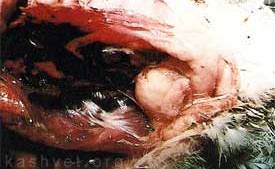In the next few posts I will discuss about the diseases in chickens. By first understanding the disease means that we've learned about his predicament, a predicament means we understand the next step into a convenience.
Basically the chicken disease in some parts categorized by the cause. The first is a disease caused by a virus, the most important thing we must understand is that the disease is caused by a virus there is no cure. Since the virus can not be turned off by any medicine. But, the disease caused by this virus can be prevented with a vaccine. So never underestimate the vaccination schedule if we do not want to regret later in life. So if we know our chickens are exposed to a disease caused by a virus, we do not buy expensive antibiotics for the treatment, as this would be useless, we should only provide vitamins just to add to the body resistance only.
Ok, now we will discuss one of the diseases which caused the Gumboro virus or IBD. I am most happy to discuss Gumboro disease is due to the one who beat me many times when I started breeding yet.
Gumboro disease is a contagious infectious disease caused by a virus, was first known in the area of Gumboro, Dela-ware the United States in this 1950.saat Gumboro spread across the world, including Indonesia. These diseases cause interference with immune-forming organs, especially Bursa Fabricius. In adult chickens Gumboro losses due not so mean. Gumboro disease infection in chicks cause damage bursa Fabricius, so having inhibition in shaping the immune substances.
Gumboro disease caused by a virus birnaviridae group. Outside the chicken's body, the virus survive more than 3 months. The virus is relatively resistant to ether, chloroform, trypsin and low pH. The virus is very sensitive to the disinfectant containing formaldehyde and iodine solution.
The disease can be chronic but sometimes acute. The disease begins with loss of appetite, tremors, inflammation around the rectum and white diarrhea. chicken feather pecking is often looked around the anus. often infect chickens aged 20-60 days, sometimes infecting chickens aged under 3 weeks. The mortality rate can reach 30-60%. The older chickens, morbidity and mortality rates tend to fall. Surgery can be found on the wreck of the bursa Fabricius changes. In acute objec bursa Fabricius undergo enlargement, inflammation and edema. Approximately 4-8 days after infection, Fabricius bursa becomes atrophic. While in a state of chronic Fabricius bursa size can be very small.
Death occurred from 2 days of visible clinical symptoms, increased at 2-3 days later and will drop rapidly at day 7 or 8. Death rates typically vary between 5-60% depending on the virulence of the virus, secondary infections and chicken age at infection.
Transmission of the stool or vomit material that contains a virus. chickens infected with the virus will be issued via the feces. Transmission may also occur indirectly through rations, drinking water, equipment cages, bird cages wild and workers contaminated
Control of the disease by vaccinating regularly.
Basically the chicken disease in some parts categorized by the cause. The first is a disease caused by a virus, the most important thing we must understand is that the disease is caused by a virus there is no cure. Since the virus can not be turned off by any medicine. But, the disease caused by this virus can be prevented with a vaccine. So never underestimate the vaccination schedule if we do not want to regret later in life. So if we know our chickens are exposed to a disease caused by a virus, we do not buy expensive antibiotics for the treatment, as this would be useless, we should only provide vitamins just to add to the body resistance only.
Ok, now we will discuss one of the diseases which caused the Gumboro virus or IBD. I am most happy to discuss Gumboro disease is due to the one who beat me many times when I started breeding yet.
Gumboro disease is a contagious infectious disease caused by a virus, was first known in the area of Gumboro, Dela-ware the United States in this 1950.saat Gumboro spread across the world, including Indonesia. These diseases cause interference with immune-forming organs, especially Bursa Fabricius. In adult chickens Gumboro losses due not so mean. Gumboro disease infection in chicks cause damage bursa Fabricius, so having inhibition in shaping the immune substances.
Gumboro disease caused by a virus birnaviridae group. Outside the chicken's body, the virus survive more than 3 months. The virus is relatively resistant to ether, chloroform, trypsin and low pH. The virus is very sensitive to the disinfectant containing formaldehyde and iodine solution.
The disease can be chronic but sometimes acute. The disease begins with loss of appetite, tremors, inflammation around the rectum and white diarrhea. chicken feather pecking is often looked around the anus. often infect chickens aged 20-60 days, sometimes infecting chickens aged under 3 weeks. The mortality rate can reach 30-60%. The older chickens, morbidity and mortality rates tend to fall. Surgery can be found on the wreck of the bursa Fabricius changes. In acute objec bursa Fabricius undergo enlargement, inflammation and edema. Approximately 4-8 days after infection, Fabricius bursa becomes atrophic. While in a state of chronic Fabricius bursa size can be very small.
Death occurred from 2 days of visible clinical symptoms, increased at 2-3 days later and will drop rapidly at day 7 or 8. Death rates typically vary between 5-60% depending on the virulence of the virus, secondary infections and chicken age at infection.
Transmission of the stool or vomit material that contains a virus. chickens infected with the virus will be issued via the feces. Transmission may also occur indirectly through rations, drinking water, equipment cages, bird cages wild and workers contaminated
Control of the disease by vaccinating regularly.

